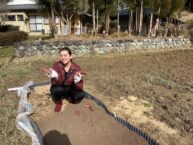For my CIP I chose to take sumi-e lessons at アトリエ喜心. I knew from the start that I wanted my CIP to be art related, and I wanted to learn about something I wouldn’t get the chance to in America. I also wanted to do something I’ve never done before, and since I’ve mostly done pencil or digital art, working with ink was a completely new experience for me.
Every week, I had two-hour lessons held at my teacher’s atelier. There were usually two or three other students as well, but they would filter in and out at their own pace. It seemed like many of the students had been going there for a long time and seemed to mostly use it as a workspace and for the materials. For my first lesson, the teacher had me paint only straight lines for two hours, which might seem menial but was actually very helpful in getting familiar with the brush and ink. I’m used to having the ability to erase or undo my mistakes, so working with a permanent medium like ink forced me to be more careful with my strokes and made me learn how to work with the mistakes I’ve made. The lessons usually consisted of choosing a sumi-e painting I liked and recreating it while receiving advice from the teacher. He would usually do a demo for me at the start, and since he would actually paint what he was explaining, it was very easy to follow along. I was also able to pick up some sumi-e and art related words. It was rewarding to see my own progress and how much more natural my strokes had become compared to the awkward, jagged lines I had made during my first lesson.
lass. There were actually a few times where I lost track of time and stayed past my lesson time. Since starting college, I haven’t had much time to do art, so it was nice that I had a scheduled time every week to paint. However, I unfortunately didn’t get many chances to speak Japanese during my lessons, since the atelier was almost always completely silent, and it was hard to start a conversation. I spoke a little with my teacher, but it was mostly just him giving guidance on what I was working on. I somewhat regret not choosing a CIP where I could talk more with other Japanese people, as a major reason why I wanted to study abroad was to improve my speaking ability. However, I’m sure a big part of the reason why I wasn’t able to talk a lot was my own shyness.
Overall, I really enjoyed my experience with taking sumi-e lessons. It was something I’ve never done before, and something I would have had trouble doing outside of Japan. However, if I could do it over, I think I would have chosen a CIP that would have given me more opportunities to speak and integrated me more into Japanese society.

